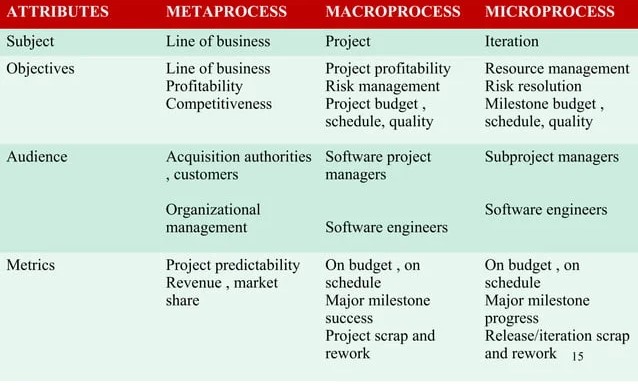Improving Software Process
Improving software process involves refining the methods, practices, and workflows used in developing software to enhance efficiency, quality, and productivity. It encompasses areas like standardizing procedures, automating tasks, continuous learning and adaptation, and optimizing workflows for better outcomes.
Process is an overloaded term. Three distinct process perspectives are:
Metaprocess:
- Definition: An organization’s overarching policies, procedures, and practices for managing software development as a business.
- Focus: Long-term strategies, economic goals, and maximizing software return on investment (ROI).
Macroprocess:
- Definition: A project’s specific policies, procedures, and practices for delivering a complete software product within given cost, schedule, and quality limits.
- Focus: Tailoring the metaprocess to fit the project’s unique constraints and requirements.
Microprocess:
- Definition: A project team’s detailed policies, procedures, and practices for creating specific parts of the software.
- Focus: Producing high-quality, functional components quickly and efficiently.


Advantages of Improving Software Process:
- Enhanced Efficiency: Streamlining processes reduces wastage of time and resources, leading to faster development cycles.
- Higher Quality: Standardized practices and continuous testing result in fewer defects and higher reliability of software.
- Cost Savings: Optimized workflows and reduced rework save costs associated with development and maintenance.
- Improved Collaboration: Clear processes promote better communication and collaboration among team members.
- Customer Satisfaction: Delivering high-quality software on time leads to greater customer satisfaction and loyalty.
Disadvantages of Improving Software Process:
- Initial Investment: Implementing process improvements may require upfront investment in tools, training, and infrastructure.
- Resistance to Change: Team members may resist changes to established processes, leading to implementation challenges.
- Overhead: Overly complex processes can create administrative overhead, slowing down development.
- Lack of Flexibility: Very rigid processes may hinder adaptability to changing project requirements or technologies.
- Potential for Over-Optimization: Focusing too much on process optimization may overlook the importance of creativity and innovation in development.